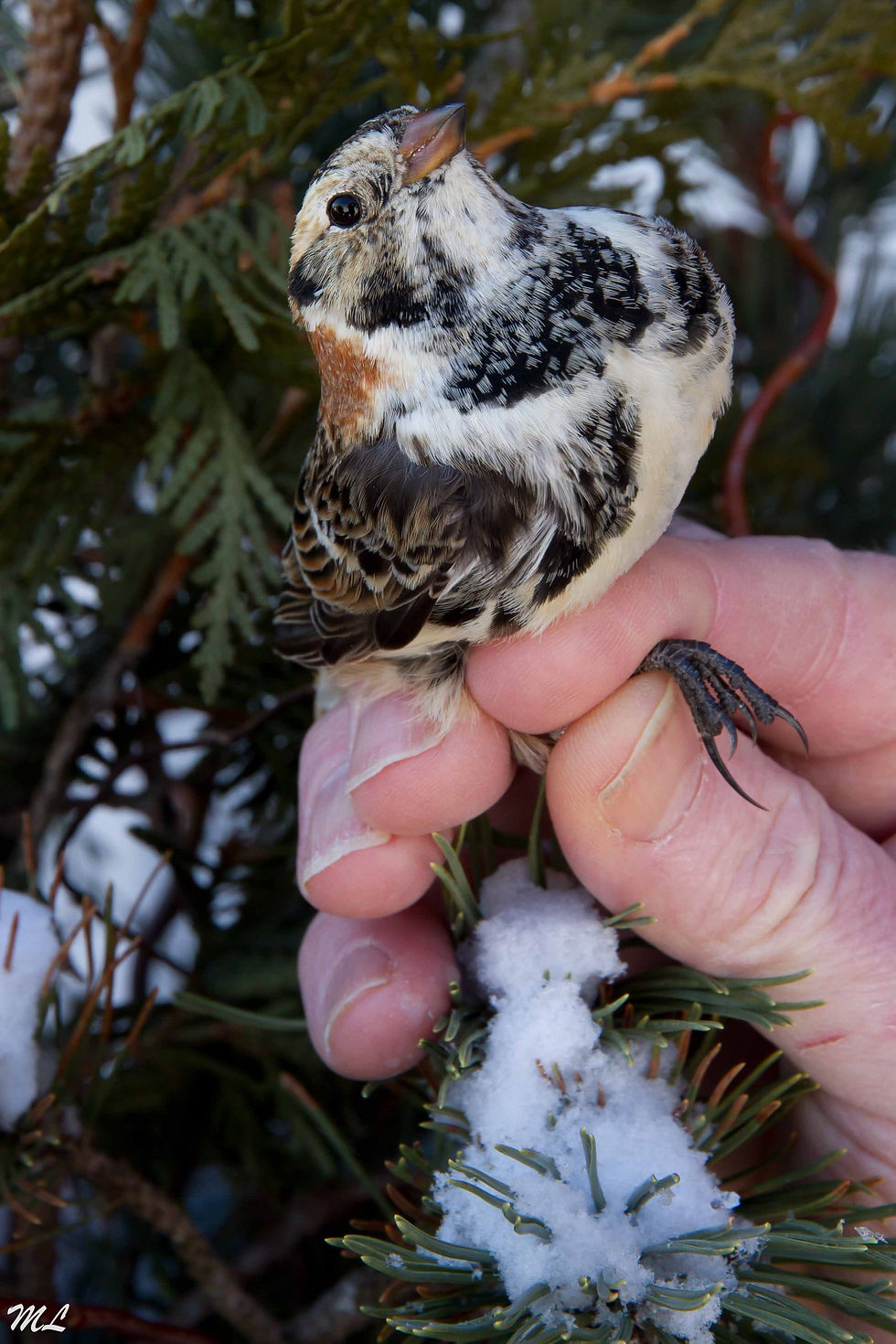Birds of Winter: Snow Buntings, Horned Larks and Lapland Longspurs
- Merri-Lee M.
- May 7, 2017
- 3 min read

Throughout the winter months, birds from Greenland and Northern Canada come to our area for their "winter vacations”. Cracked corn spread along the edge of an open field attracts hundreds of hungry visitors between December and March. Many flocks arrive in our area during February and March, likely when they are on their way back to breeding grounds in the North. Birds are banded in this area in order to track their migration paths and ages. (Photos of birds in hand were taken during banding.)

Most of the birds in a Winter flock are Snow Buntings. They arrive as a group in a flutter of black and white, eat corn together, and rise in a cloud to move over the fields, only to repeat their actions many times over the next few hours.

Or they land on the wires above the corn, and dive down to eat...




When the Snow Buntings arrive, the males are quite colourful with their orange bills and rust-coloured “necklaces”, cheeks, sides, and head markings.

The females are a duller brown where the males are black, but they are still lovely --- and just as hungry!

As the Winter progresses, and the Snow Buntings begin to think about heading North again, they “rub” the rust colour off their feathers, and their bills darken to black. The birds we see in early March are almost completely black and white.

Late-Season Snow Bunting with Lapland Longspur:

Along with the Snow Buntings, there are 2 subspecies of Horned Larks that come to eat corn. The first is the Hoyt’s Horned Lark . The males of this type exhibit a white band above the eyes and a yellowish patch on the throat.



The second subspecies of Horned Lark is the Northern Horned Lark. Males have a yellow band over the eyes and a yellow throat.


The female is not as boldly coloured, but displays the yellow face.

Some Horned Larks are hard to distinguish one from the other, as the white band above the eyes appears to be a buffy colour, neither yellow nor white. All Horned Larks, regardless of type, can use their little “horns” to express their displeasure or alarm!

The third species that often appears (in lesser numbers than the Snow Buntings or Horned Larks) in winter in the “Snowbird” flocks is the beautiful Lapland Longspur. Males have a very distinctive rust-coloured patch bordered with clean white on the back of the neck, a buffy stripe above the eye, and a buff cheek. The feathers on the back and sides are intricately detailed in black, brown, rust and white, and the “bib” is mottled black/white.


Female Lapland Longspurs are, again, less dramatically marked, but have the same C-shaped marking on the cheek.

As the season progresses, the male Lapland Longspurs begin to darken through the chest and head to a deep black colour.

By the time March arrives, we are treated to views of the "almost-full breeding plumage" of the male Lapland Longspurs in their last days of their southern vacations! Bills are orange, and a black mask nearly covers the face.



It is a real privilege to have these stunning winter visitors along the edge of our corn field, directly outside our dining room window. While they are in the area from December until March, depending on weather, we usually see the largest numbers at this location in February and early March. Some will migrate west along the St. Lawrence River when they leave here, and then fly north to Greenland or Iqaluit or other spots in the cold northern regions. They only visit our area for a short while to feed (voraciously!) before they move on to their breeding grounds.
And I am always just a little sad to see them heading out on their long journeys. Until next winter......be safe, little ones!

--------------------------------------------------------------------------
Special thanks to David Lamble, Master Bander, for all of his patience and expertise!




Comments